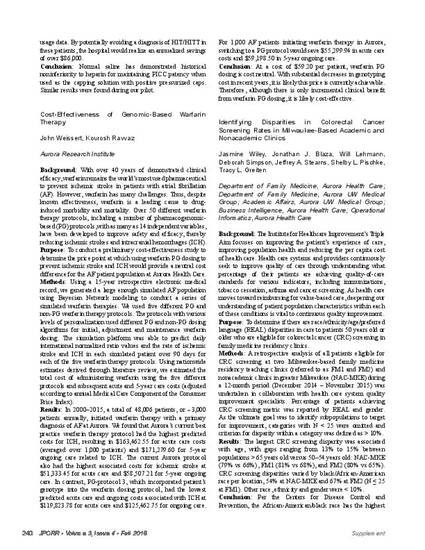
- colorectal cancer,
- screening,
- health disparities,
- residency
Background: The Institute for Healthcare Improvement’s Triple Aim focuses on improving the patient’s experience of care, improving population health and reducing the per capita cost of health care. Health care systems and providers continuously seek to improve quality of care through understanding what percentage of their patients are achieving quality-of-care standards for various indicators, including immunizations, tobacco cessation, asthma and cancer screening. As health care moves toward reimbursing for value-based care, deepening our understanding of patient population characteristics within each of these conditions is vital to continuous quality improvement.
Purpose: To determine if there are race/ethnicity/age/preferred language (REAL) disparities in care to patients 50 years old or older who are eligible for colorectal cancer (CRC) screening in family medicine residency clinics.
Methods: A retrospective analysis of all patients eligible for CRC screening at two Milwaukee-based family medicine residency teaching clinics (referred to as FM1 and FM2) and nonacademic clinics in greater Milwaukee (NAC-MKE) during a 12-month period (December 2014 – November 2015) was undertaken in collaboration with health care system quality improvement specialists. Percentage of patients achieving CRC screening metric was reported by REAL and gender. As the ultimate goal was to identify subpopulations to target for improvement, categories with N < 25 were omitted and criterion for disparity within a category was defined as > 10%.
Results: The largest CRC screening disparity was associated with age, with gaps ranging from 13% to 15% between populations > 65 years old versus 50–54 years old: NAC-MKE (79% vs 66%), FM1 (81% vs 68%), and FM2 (80% vs 65%). CRC screening disparities varied by black/African-American race per location, 54% at NAC-MKE and 67% at FM2 (N ≤ 25 at FM1). Other race, ethnicity and gender were < 10%.
Conclusion: Per the Centers for Disease Control and Prevention, the African-American/black race has the highest CRC death, making early CRC screening an imperative. While the Wisconsin Collaborative for Healthcare Quality ranks Aurora Health Care as eighth out of 20 systems in Wisconsin (77.6% from 2014 Q3 to 2015 Q2), local data analysis identified age as the largest disparity gap. Analyzing local population REAL/gender data provides key insights to support initiatives to reduce health disparity gaps and further progress toward achieving the Triple Aim for health care.
Wiley J, Blaza JJ, Lehmann W, Simpson D, Stearns JA, Pischke SL, Greiten TL. Identifying disparities in colorectal cancer screening rates in Milwaukee-based academic and nonacademic clinics. J Patient Cent Res Rev. 2016;3:240-1.
